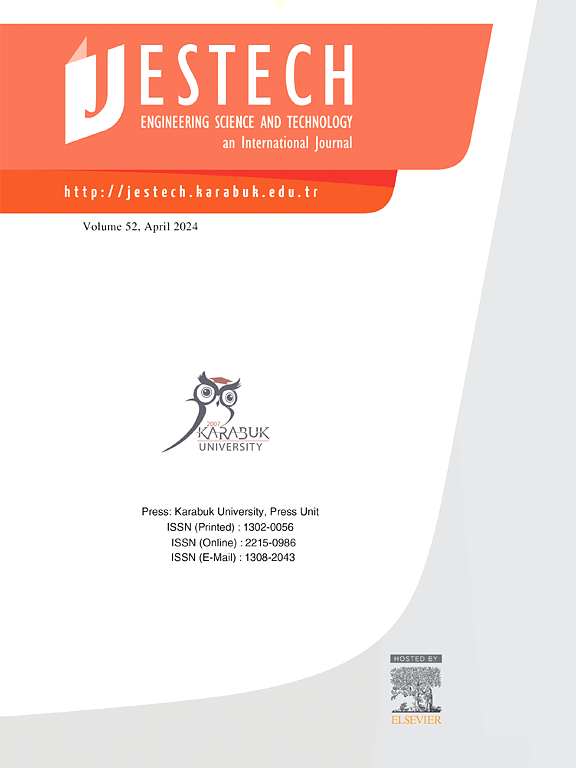Detection of high-risk diseases in poultry feces through transfer learning
IF 5.1
2区 工程技术
Q1 ENGINEERING, MULTIDISCIPLINARY
Engineering Science and Technology-An International Journal-Jestech
Pub Date : 2025-02-21
DOI:10.1016/j.jestch.2025.102002
引用次数: 0
Abstract
Poultry farming industry constitutes a significant part of the global economy. Deep learning technology possesses the ability to autonomously analyze images, allowing constructed models to aid in the analysis and management of the poultry farming industry, particularly in early detection of sick poultry. Ensuring a sustainable industrial white meat production relies significantly on maintaining a high-quality living environment and early detection of diseases with prompt preventive measures. Early diagnosis of infectious and high-risk diseases such as Coccidiosis, Salmonellosis, and Newcastle disease, coupled with taking necessary precautions, will contribute to the efficient functioning of global economies supply chain. This study aims to detect high-risk Coccidiosis, Salmonellosis, and Newcastle diseases in poultry through transfer learning using poultry feces. Six different transfer learning architectures, namely DenseNet201, Resnet152V2, InceptionV3, InceptionResnetV2, MobileNetV2, and Xception, were employed in the study due to their widespread use and high accuracy rates.
The analysis revealed that MobileNetV2 achieved the highest accuracy rate of 97.1%. Considering the training times, it was observed that MobileNetV2 also exhibited the fastest training. The results of the analysis provide evidence that disease analysis from poultry feces can be carried out with high accuracy through transfer learning in the context of sustainable white meat production.
求助全文
约1分钟内获得全文
求助全文
来源期刊

Engineering Science and Technology-An International Journal-Jestech
Materials Science-Electronic, Optical and Magnetic Materials
CiteScore
11.20
自引率
3.50%
发文量
153
审稿时长
22 days
期刊介绍:
Engineering Science and Technology, an International Journal (JESTECH) (formerly Technology), a peer-reviewed quarterly engineering journal, publishes both theoretical and experimental high quality papers of permanent interest, not previously published in journals, in the field of engineering and applied science which aims to promote the theory and practice of technology and engineering. In addition to peer-reviewed original research papers, the Editorial Board welcomes original research reports, state-of-the-art reviews and communications in the broadly defined field of engineering science and technology.
The scope of JESTECH includes a wide spectrum of subjects including:
-Electrical/Electronics and Computer Engineering (Biomedical Engineering and Instrumentation; Coding, Cryptography, and Information Protection; Communications, Networks, Mobile Computing and Distributed Systems; Compilers and Operating Systems; Computer Architecture, Parallel Processing, and Dependability; Computer Vision and Robotics; Control Theory; Electromagnetic Waves, Microwave Techniques and Antennas; Embedded Systems; Integrated Circuits, VLSI Design, Testing, and CAD; Microelectromechanical Systems; Microelectronics, and Electronic Devices and Circuits; Power, Energy and Energy Conversion Systems; Signal, Image, and Speech Processing)
-Mechanical and Civil Engineering (Automotive Technologies; Biomechanics; Construction Materials; Design and Manufacturing; Dynamics and Control; Energy Generation, Utilization, Conversion, and Storage; Fluid Mechanics and Hydraulics; Heat and Mass Transfer; Micro-Nano Sciences; Renewable and Sustainable Energy Technologies; Robotics and Mechatronics; Solid Mechanics and Structure; Thermal Sciences)
-Metallurgical and Materials Engineering (Advanced Materials Science; Biomaterials; Ceramic and Inorgnanic Materials; Electronic-Magnetic Materials; Energy and Environment; Materials Characterizastion; Metallurgy; Polymers and Nanocomposites)
 求助内容:
求助内容: 应助结果提醒方式:
应助结果提醒方式:


